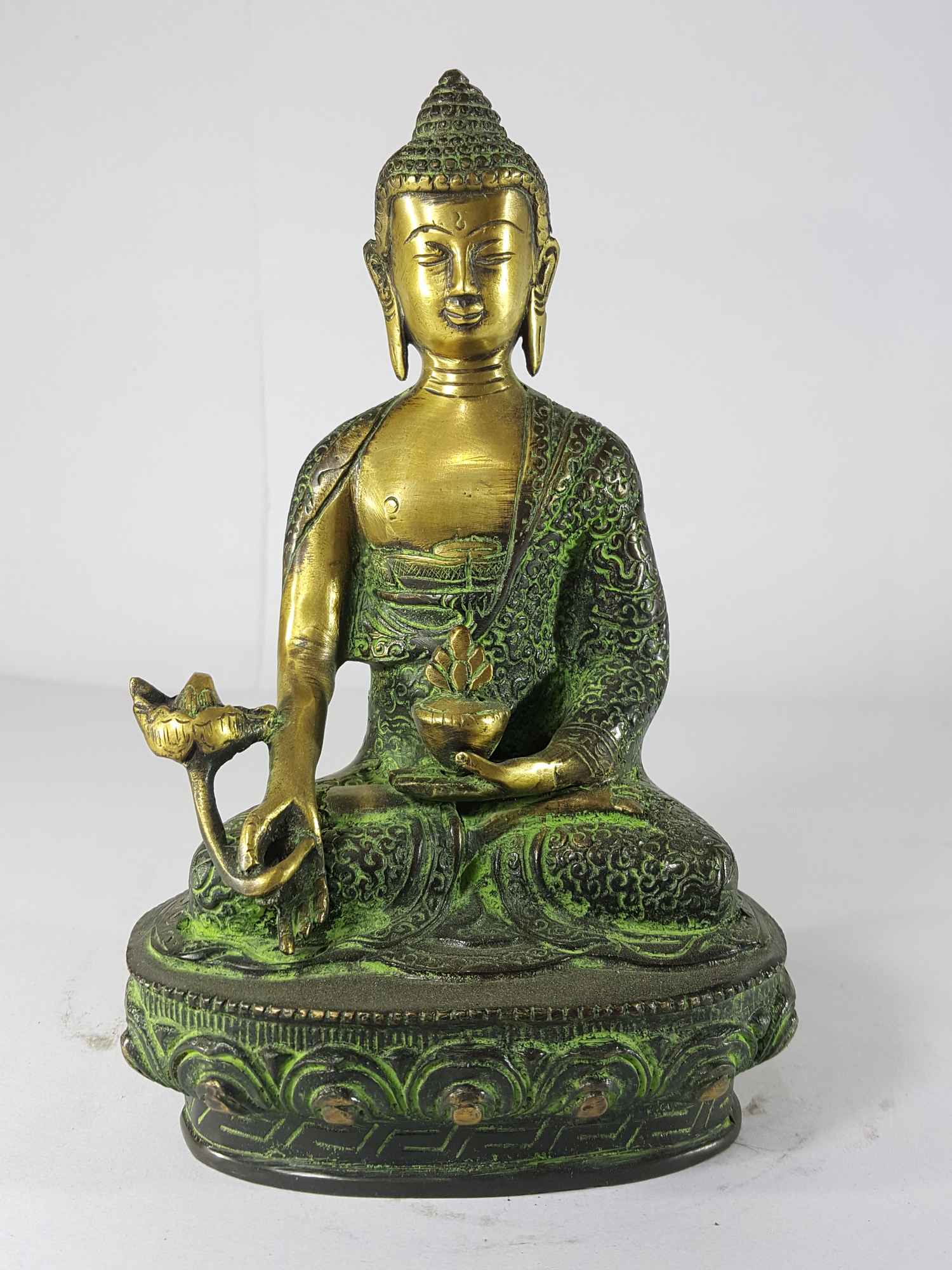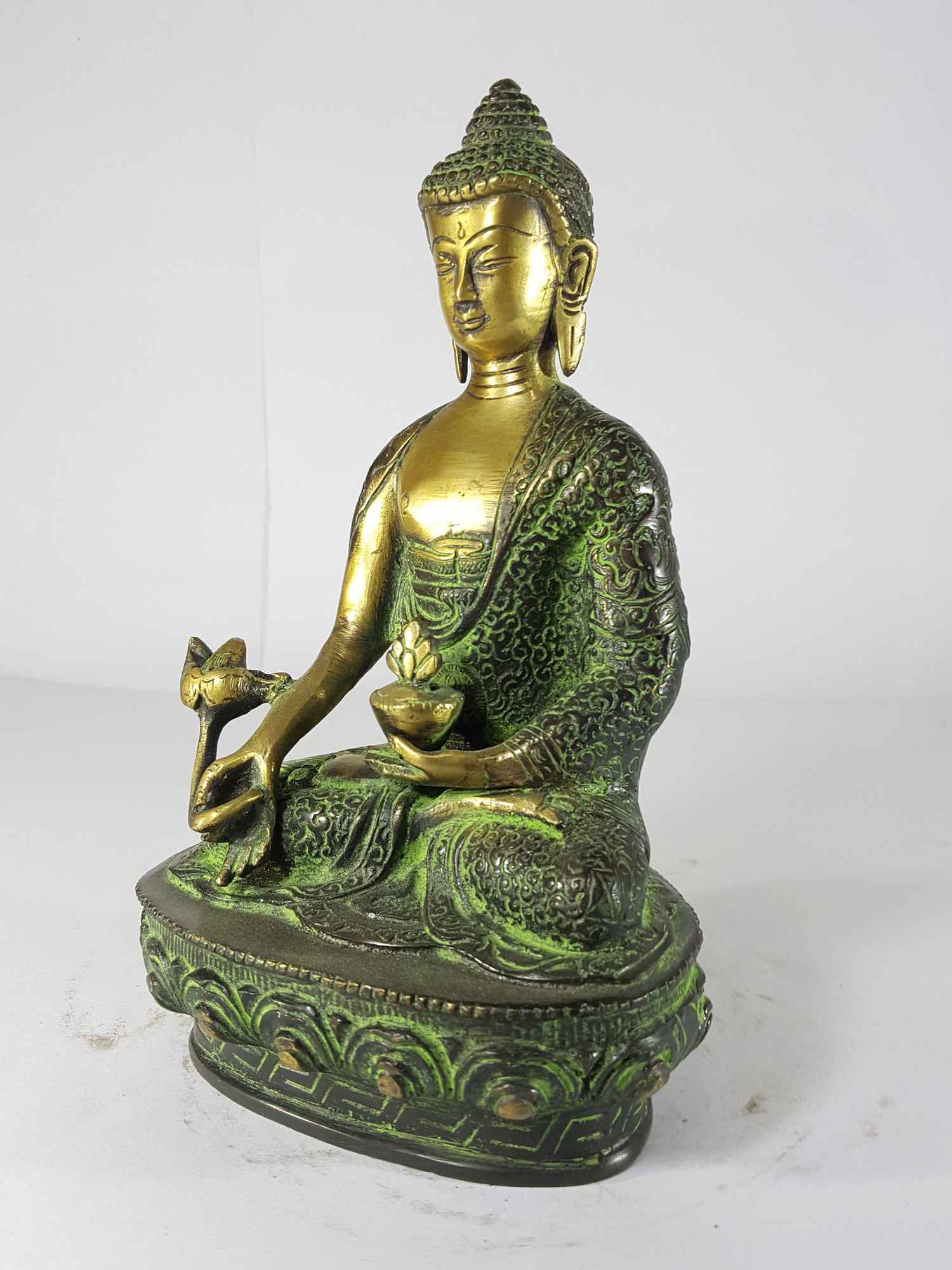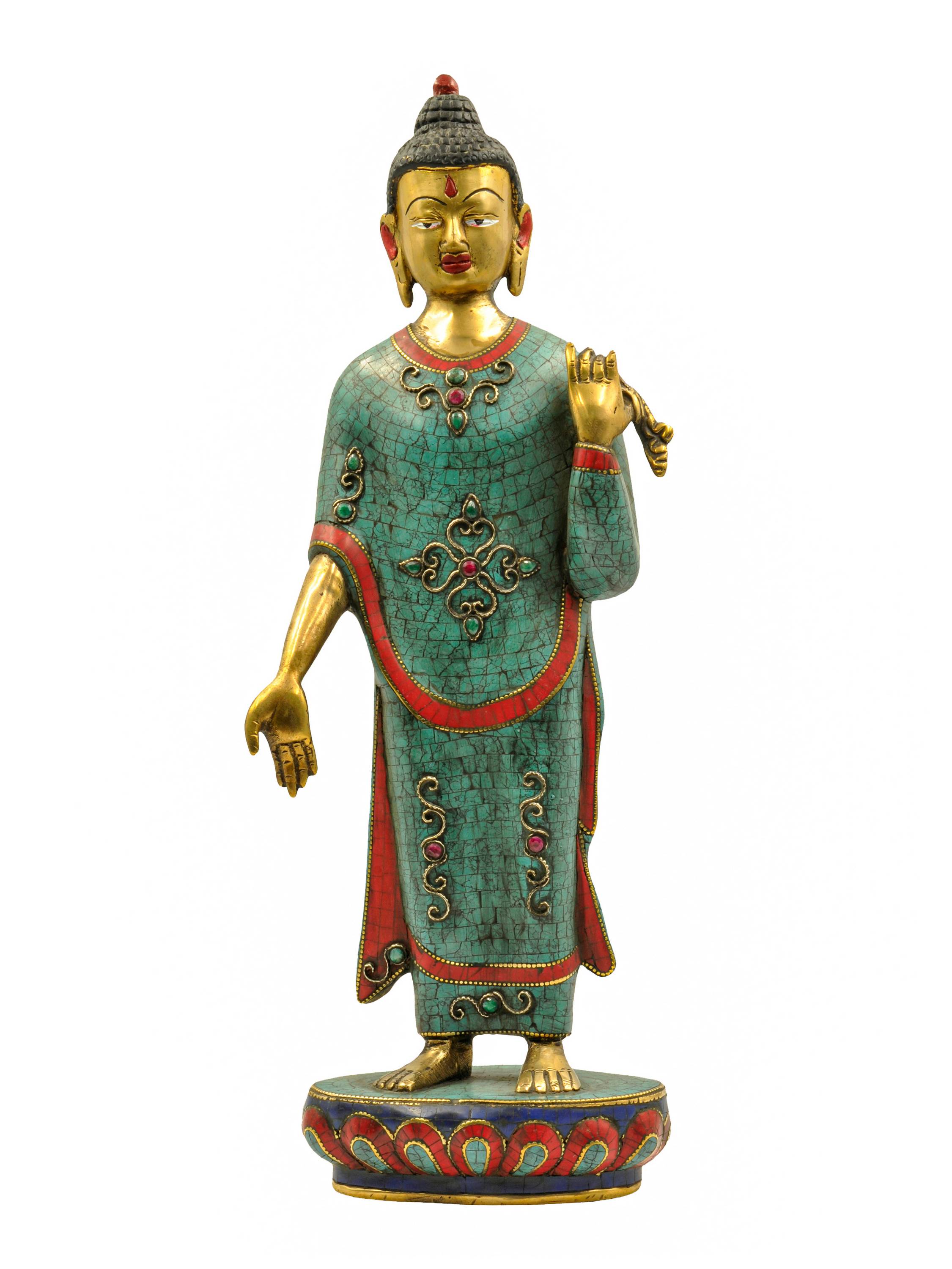Code
HCS27812
Weight
3.065 Kg / 6.76 lbs
Size
Height
37cm (15") Width
25cm (10") Depth
13cm (5") Material
Copper
Availability
Available

Safe Payment
We accept Paypal, Money Transfer, Bank Transfer
Confidence
Protection covers your purchase and personal data.
Worldwide Delivery
We ship Worldwide, except Russia.Shipping cost US$25.2 for upto 0.5 kgs

Hotline
Talk to help line for your question on 9841267335About Chocolate Oxidized
This Buddhist Statue Of Medicine Buddha, [sand Casting], [chocolate Oxidized] has been meticulously treated with a chocolate color antique patina. The intention behind this patina is to replicate the appearance of a copper statue that has gracefully aged over a century. Unlike a simple coat of paint, this patina is not applied superficially and is designed to endure. It undergoes an artificial oxidation process that adds depth and character, while also serving as a protective layer against natural oxidation.
By imitating the natural aging process, the chocolate color antique patina lends an air of authenticity and vintage charm to the Buddhist Statue Of Medicine Buddha, [sand Casting], [chocolate Oxidized]. This carefully crafted finish ensures that the patina remains intact for an extended period, offering longevity and resistance to wear. The result is a unique piece that captures the essence of a time-worn copper statue, evoking a sense of history and artistic heritage.
This Buddhist Statue Of Medicine Buddha, [sand Casting], [chocolate Oxidized] has been meticulously treated with a chocolate color antique patina. The intention behind this patina is to replicate the appearance of a copper statue that has gracefully aged over a century. Unlike a simple coat of paint, this patina is not applied superficially and is designed to endure. It undergoes an artificial oxidation process that adds depth and character, while also serving as a protective layer against natural oxidation.
By imitating the natural aging process, the chocolate color antique patina lends an air of authenticity and vintage charm to the Buddhist Statue Of Medicine Buddha, [sand Casting], [chocolate Oxidized]. This carefully crafted finish ensures that the patina remains intact for an extended period, offering longevity and resistance to wear. The result is a unique piece that captures the essence of a time-worn copper statue, evoking a sense of history and artistic heritage.
Process: Sand Casting
This Buddhist Statue Of Medicine Buddha, [sand Casting], [chocolate Oxidized] has been created using the sand casting system, also known as sand molding casting. This widely employed manufacturing process utilizes a sand mold to produce metal products and components in various sizes and shapes. Sand casting holds significant popularity in the industry, accounting for approximately 60% of all metal castings. The sand casting process involves six primary steps. First, a pattern or replica of the desired sculpture, in this case, Buddhist Statue Of Medicine Buddha, [sand Casting], [chocolate Oxidized], is created using a material like wood or metal. The pattern is then placed in a flask, which is a box-like structure divided into two halves. The next step involves packing the flask tightly with specially formulated molding sand, creating a mold cavity that matches the shape of the pattern. The pattern is subsequently removed, leaving behind a negative impression of the sculpture within the sand mold. Read More . . .
This Buddhist Statue Of Medicine Buddha, [sand Casting], [chocolate Oxidized] has been created using the sand casting system, also known as sand molding casting. This widely employed manufacturing process utilizes a sand mold to produce metal products and components in various sizes and shapes. Sand casting holds significant popularity in the industry, accounting for approximately 60% of all metal castings. The sand casting process involves six primary steps. First, a pattern or replica of the desired sculpture, in this case, Buddhist Statue Of Medicine Buddha, [sand Casting], [chocolate Oxidized], is created using a material like wood or metal. The pattern is then placed in a flask, which is a box-like structure divided into two halves. The next step involves packing the flask tightly with specially formulated molding sand, creating a mold cavity that matches the shape of the pattern. The pattern is subsequently removed, leaving behind a negative impression of the sculpture within the sand mold. Read More . . .
Brief Introduction :
Bhaisajyaguru is known as the Medicine Buddha. He is also called the Healing Buddha. It is said that he dispenses spiritual medicine when properly worshipped. There is even a belief that an efficacious cure may be accomplished by merely touching his image. In Tibet, he may be represented either as a Buddha or as a Bodhisattva. As a Buddha, he exhibits the urn (a small round bulge or protuberance above the bridge of the nose), which is the fourth superior mark of a Buddha, and the Ushnisha (a bulge or protuberance on the top of the Buddha's skull), which is the first superior mark of a Buddha. He has short and curly hair, wears a monastic robe, and is seated with his legs crossed. His left hand, lying in his lap in a meditation mudra, usually holds the medicine bowl, while his right hand, in a charity mudra, holds either a branch with fruit or the fruit alone of the myrobalan, a medicinal plant found in India and other tropical countries.
Iconography :Medicine Buddha is the popular term for Bhaisajyaguru and refers to healing blue light transmitted by his representation and conception. Bhaisajyaguru means "Master of Blue Light". His healing energy is transmitted through blue light wave length called Vaydurya light. Medicine Buddha radiates this healing energy. Think of the light as internal chakra energy. The colour blue has been known for its purifying properties since ancient times and the deep blue colour of the Medicine Buddha is directly associated with this blue Vaydurya light energy. The energy source originates in the transparent beryl crystal bowl the Medicine Buddha supports and manifests itself in the deep blue of Lapis Lazuli [Lapis] of his corporeal body. The goldenergy lines [Skt. Chritrini] of his psychic body link all the yogic "vital airs" or energy winds [Skt. Vayus] and form the Beryl healing light energy beryl blue band of the inner aureole representing all the vital airs [Skt. Vyana] of the subtle body [Skt. Pranamayakosha]. As we journey through life we can find ourselves suffering through illness or through the illness of someone else. During illness previous priorities seem almost irrelevant as we seek to restore our balance or to find a new balance in our lives. Suddenly the medicine Buddha who is often overlooked becomes the most important of all while we realise our oversight. The image of the medicine Buddha can be used as a meditation deity [Skt. Ishta-devata] texts often call a meditation deity a Tutelary Deity or a Yidam Deity. A Yidam is the Tibetan word for an Ishtar-devata, a fully enlightened being who is the focus of personal meditation, during a retreat or for life. Deity Yoga practices can be undertaken. In essence, the mindstream of the guru and the yidam are indivisible. The yidam is considered to be the root of success in the practice. Visualise his serenity & healing light.
His extended left hand with an open front palm is shown in gift bestowing [Skt. Varada] hand gesture [Skt. Mudra] and holds the stem of a triple fruited myrobalan plant between his thumb & forefinger. In Tibetan medicine the myrobalan plant is known as the 'King of Medicines' on account of its medicinal properties. The gift bestowing hand gesture represents his dispensing of healing and holds a myrobalan plant bearing three myrobalan fruits. The number three refers to Principle of Three Gunas, which are Energy [Skt. Rajas] Inertia/Movement [Skt. Tamas] & wholeness or bodily order [Skt. Sattwa] When balanced we enjoy good health, when unbalanced illness can arise. Our bodies have a remarkable ability to rebalance if we allow them in a process known as homeostasis, directly linked to the principle of the Gunas. Unbalancing can occur when the moon residing at the naval root absorbs too much form the sun at the palette root which relates to too much sensual indulgence with the and the nectar of the moon is.
The right hand of Medicine Buddhas rests upon his lap in the position associated with an advanced connection with the inner self arrived at through meditation, commonly called the meditative state. The same hand supports a blue beryl crystal alms bowl containing medicinal nectar and a myrobalan fruit. He is portrayed wearing maroon monastic robes painted seated on a white moon disc in a lotus body position [Skt. Padmasana] and upon an actual lotus flower. Magical Buddhism [Tantric Buddhism] is very connected with Although more commonly linked to Vedic Yoga.
Commentary :His extended left hand with an open front palm is shown in gift bestowing [Skt. Varada] hand gesture [Skt. Mudra] and holds the stem of a triple fruited myrobalan plant between his thumb & forefinger. In Tibetan medicine the myrobalan plant is known as the 'King of Medicines' on account of its medicinal properties. The gift bestowing hand gesture represents his dispensing of healing and holds a myrobalan plant bearing three myrobalan fruits. The number three refers to Principle of Three Gunas, which are Energy [Skt. Rajas] Inertia/Movement [Skt. Tamas] & wholeness or bodily order [Skt. Sattwa] When balanced we enjoy good health, when unbalanced illness can arise. Our bodies have a remarkable ability to rebalance if we allow them in a process known as homeostasis, directly linked to the principle of the Gunas. Unbalancing can occur when the moon residing at the naval root absorbs too much form the sun at the palette root which relates to too much sensual indulgence with the and the nectar of the moon is.
The right hand of Medicine Buddhas rests upon his lap in the position associated with an advanced connection with the inner self arrived at through meditation, commonly called the meditative state. The same hand supports a blue beryl crystal alms bowl containing medicinal nectar and a myrobalan fruit. He is portrayed wearing maroon monastic robes painted seated on a white moon disc in a lotus body position [Skt. Padmasana] and upon an actual lotus flower. Magical Buddhism [Tantric Buddhism] is very connected with Although more commonly linked to Vedic Yoga.
This is why the ideas in Patanjali's Yoga Sutra are so closely connected with the Buddhist Principle of The Four Noble Truths and on gaining the liberated path. There are many other connections with Yoga such as the tantric gold energy lines [Skt. Chitrini] the lotus and chakras and in the choice of colours of aureoles. Perhaps most obvious is the classic yoga lotus asana with one leg crossed over the other that the Medicine Buddha is sitting in. The wisdom of Devata Yoga will help.
Matra of Medicine Buddha
namo bhagavate bhaiśajyaguru vaidūryaprabharājāya tathāgatāya arhate samyaksambuddhāya tadyathā: oṃ bhaiśajye bhaiśajye bhaiśajya-samudgate svāhā.


![Buddhist Statue Of Medicine Buddha, [sand Casting], [chocolate Oxidized]](https://handicraftseller.com/uploads/pics/product/thumb/2023/01/27812.jpg)
![Buddhist Statue Of Medicine Buddha, [sand Casting], [chocolate Oxidized]](https://handicraftseller.com/uploads/pics/product/thumb/2023/01/27812_0.jpg)
![Buddhist Statue Of Medicine Buddha, [sand Casting], [chocolate Oxidized]](https://handicraftseller.com/uploads/pics/product/thumb/2023/01/27812_1.jpg)
![Buddhist Statue Of Medicine Buddha, [sand Casting], [chocolate Oxidized]](https://handicraftseller.com/uploads/pics/product/thumb/2023/01/27812_2.jpg)
![Buddhist Statue Of Medicine Buddha, [sand Casting], [chocolate Oxidized]](https://handicraftseller.com/uploads/pics/product/thumb/2023/01/27812_3.jpg)

 of Shakyamuni Buddha,
of Shakyamuni Buddha,  of Shakyamuni Buddha,
of Shakyamuni Buddha,  Sand Casting,
Sand Casting,  Sand Casting,
Sand Casting,  of Dipankara Buddha, Or Standing Buddha,
of Dipankara Buddha, Or Standing Buddha,  of Dipankara Buddha, Or Standing Buddha,
of Dipankara Buddha, Or Standing Buddha,  with Turquoise, Lapis
with Turquoise, Lapis  with Turquoise, Lapis
with Turquoise, Lapis  of Shakyamuni Buddha,
of Shakyamuni Buddha,  of Shakyamuni Buddha,
of Shakyamuni Buddha,  of Shakyamuni Buddha,
of Shakyamuni Buddha,  of Shakyamuni Buddha,
of Shakyamuni Buddha,  Sand Casting,
Sand Casting,  Sand Casting,
Sand Casting,  of Medicine Buddha,
of Medicine Buddha,  of Medicine Buddha,
of Medicine Buddha,  of Samantabhadra In Antique Finishing" title="Statue
of Samantabhadra In Antique Finishing" title="Statue  of Samantabhadra In Antique Finishing" title="Statue
of Samantabhadra In Antique Finishing" title="Statue  of Amoghsiddhi Or Blessing Buddha" title="Statue
of Amoghsiddhi Or Blessing Buddha" title="Statue  of Amoghsiddhi Or Blessing Buddha" title="Statue
of Amoghsiddhi Or Blessing Buddha" title="Statue